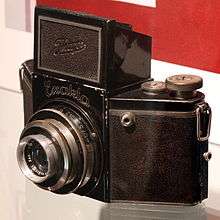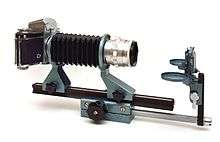Exakta

The Exakta is a pioneer brand camera produced by the Ihagee Kamerawerk in Dresden, Germany, founded as the Industrie und Handels-Gesellschaft mbH, in 1912. The inspiration and design of both the VP Exakta and the Kine Exakta are the work of the Ihagee engineer Karl Nüchterlein (see Richard Hummel's Spiegelreflexkameras aus Dresden), who did not survive the Second World War.
Characteristics

Highlights of Exakta cameras include:
- First single-lens reflex camera (SLR) for 127 roll film (VP Exakta) came in 1933.
- First wind-on lever in 1934.
- First built-in flash socket, activated by the shutter, in 1935.
- First SLR for 35mm film came in 1936, the Kine Exakta.
Early Kine Exaktas had a fixed waist-level viewfinder, but later models, starting with the Exakta Varex, had an interchangeable waist- or eye-level finder. Examat and Travemat Through-the-lens metering prisms were introduced in the mid-1960s. Most controls—including the shutter release and the film wind lever—are on the left-hand side, unlike most other cameras. The film is transported in the opposite direction to other 35mm SLRs. In classic Exaktas—made between 1936 and 1969—two film canisters can be used, one containing unexposed film and a second into which is wound the exposed film. A sliding knife built into the bottom of the camera can be used to slice the film so that the canister containing the exposed film can be removed while preserving the unexposed film in the main canister. The knife was omitted in the Exakta VX500, one of the last "official" Exakta cameras.
The shutter release on classic Exaktas is on the front of the camera, rather than the top. It is pressed with the left forefinger. This is quite similar to the Praktina design (which adapted it from Ihagee's product), the shutter-release of which was located on the right-hand side of the camera-body front. Most later lenses produced for Exakatas (Ihagee did not produce their own lenses), known either as "automatic" or "semi-automatic" lenses, included a button in an extension that would align over the camera body's shutter release when the lens was mounted. The diaphragm of these lenses remained fully open, providing a bright viewfinder image, until the button was depressed halfway, when the iris would be stopped down to the shooting aperture; pressed farther, the lens button engaged the camera's shutter release button, tripping the shutter.

There was a full line of specialized equipment available for these 'system' cameras that included microscope adaptor, extension bellows, stereo attachments, medical attachments and various specialized finder screens. Equipment is fully compatible between all models manufactured between 1936 and 1969. The spelling found on cameras has traditionally been Exakta, but some early Kine-Exaktas were marked Exacta specifically for marketing in France, Portugal and the U.S., perhaps for copyright reasons; and certainly a great number of American collectors refer to the whole range as the "Exacta." A related line of smaller, simpler cameras was the "Exa" line; these, too, existed in several variations. The Beseler Topcon line of 35mm cameras used the same lens mount as the Exakta. In the early 1970s the Exakta "RTL 1000" was introduced; it accepted the older models' lenses but had its own range of viewfinders, which included a model with through-the-lens light metering. Because of this lack of backwards compatibility the RTL series is generally not regarded as part of Ihagee's Exakta line; most collectors consider the VX1000 the last "official" Exakta camera. M42 lens mount variants of the RTL line of cameras also appeared under the Practica name.
After an economic collapse following Germany's reunification, the successor of the firm (Pentacon, which subsumed Ihagee) is now back in business. This company is not related to the Dutchman Johan Steenbergen, the founder/owner of Ihagee, or with the Exakta, which was discontinued in the 1970s.
Models
- 127 roll-film Exaktas:
- VP Exakta A
- VP Exakta B
- VP Exakta C
- VP Exakta Junior
- VP Exakta Night
- 120 roll-film Exaktas:
- Exakta 6x6 (VP shape)
- Exakta 6x6 (upright shape)
- 135 small-format Exaktas:
- Kine Exakta
- Kine Exakta II
- Exakta Varex (*in US, Exakta V)
- Exakta Varex VX (*in US, Exakta VX)
- Exakta Varex (*VX) IIa
- Exakta Varex (*VX) IIb
- Exakta VX500
- Exakta VX1000
- 135 small-format Exas:
- Exa
- Exa I
- Exa Ib
- Exa Ic
- Exa II
- Exa IIa
- Exa IIb
- Exa 500
- Exakta 500
- VX 100
- VX 200
For political and copyright reasons, prototype and special export models were produced using the names Elbaflex and Elbina.
The Exakta RTL1000, later simply RTL 1000, is generally not considered a true Ihagee Exakta having only the lens mount in common with earlier Ihagee Exaktas.
- As the name "Varex" was already a registered trademark in the USA (series of lenses by the Argus company), the name "Varex" was not permitted to adorn Exakta cameras built to be shipped to the United States of America. As such, cameras sold in Europe that bore the name "Varex," were usually sold in the United States as "V" or "VX". Some camera imports were simply censored during shipment, their "Varex" stricken out with a silver to match the colour of the camera body.
Trivia
- An Exakta camera was used by the main character (who was a photographer) in the 1954 Alfred Hitchcock film Rear Window. The camera that features prominently in the film can be identified as a 35mm Exakta Varex VX with a Kilfitt Fern-Kilar f/5.6 400mm lens.[1]
- An Exakta camera, loaded with salvaged movie film, was used by Czech photographer Josef Koudelka to capture his historic photojournalistic images of the 1968 Prague Spring.
- An Exakta camera is seen being used by the spy/minder Masahiko Amakasu (Ryuichi Sakamoto) during the enthronement of Puyi as emperor of Manchukuo in the 1987 film The Last Emperor. The camera seen however is an anachronism: the enthronement scene is set in the late 1930s; the Exakta camera in it is a VXIIa from the 1960s- the camera's logo is the 'new' block letter all-caps style and not the original beautiful cursive logo.
- An Exakta is also seen in "The Public Eye" (1992 starred Joe Pesci and Barbara Hershey), a Weegee inspired film about a police news photographer, set in the 1940s. Again, the Exakta seen, a V or VX (or Varex) with an eyelevel finder, is anachronistic. Exakta did not get to have eyelevel finders until the model V introduced in 1950.
- An Exakta camera was used by the main character in the 2011 Oscar-nominated movie Extremely Loud & Incredibly Close.
Further reading
- Exakta Cameras 1933–1978, Aguila, Clément and Michel Rouah, 1989, Hove Photo Books, Hove, East Sussex ISBN 0-906447-38-0
- Collecting and Using Classic SLRs, Matanle, Ivor, 1997, Thames and Hudson, New York, ISBN 0-500-27901-2
- Exakta Collection 1933-1987, Clément Aguila & Michel Rouah - DDP Image Edition, France, 2003. ISBN 2-9519891-0-5
- Spiegelreflexkameras aus Dresden, Richard Hummel, Spiegelreflexkameras aus Dresden. Edition Reintzsch Leipzig, 1995, ISBN 3-930846-01-2 oder 3-89506-127-1
See also
References
External links
- Ihagee & Exakta Products and History
- Exakta cameras
- Andrzej Wrotniak's site on the small-format (135 or "35mm") cameras and accessories
- Comprehensive site on small-format Exaktas
- Exakta VP Sliding Pages
- 35mm Exakta Sliding Pages
- PENTACON GmbH, The camera company, Dresden, Germany, today
- Start SLR Soviet Exakta Copy by Stephen Rothery
- Exakta instruction guides in PDF format
- Kiné Exakta, Exakta VX, and Exa at Marc's Classic Cameras
- The Official Site of the Exakta Circle, founded in 1990